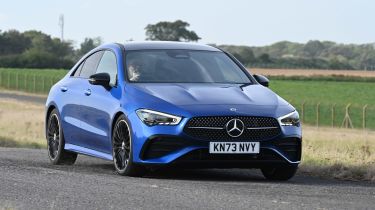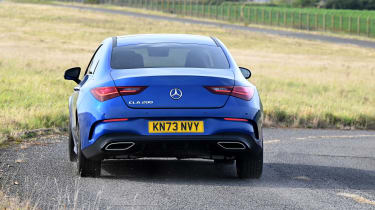Mercedes CLA - Engines, drive & performance
A widened stance gives the Mercedes CLA more engaging handling than before
While the first CLA was very much an A-Class with a coupe-inspired design, Mercedes aimed to give its second-generation CLA a more distinct personality, making room for the arrival of the Mercedes A-Class Saloon. In keeping with its sporting design, this has largely focused on making the CLA better to drive than the more mainstream, and less expensive, hatchback and saloon versions.
For a start, the front and rear axles are much broader. Not only does this give the CLA a wider, more assertive stance, but it also has a positive effect on its handling. We think the CLA feels more responsive than the A-Class Saloon and there’s reduced body lean through corners, so we recommend the CLA more for driving enthusiasts. It also corners more enthusiastically than the Audi A3 and resists body roll better, giving it a more athletic feel.
However, the CLA still doesn’t quite have the poise of the BMW 2 Series Gran Coupe, making that the better choice for the keenest of drivers. The mild-hybrid setup also appears to have made the brakes feel somewhat inconsistent, with a mixture of physical braking and energy recuperation making it more difficult to come to a smooth halt.
Mercedes CLA petrol engines
Badged CLA 180 and 200, the entry-level petrol engine is a 1.3-litre turbo found in numerous small Mercedes models. With front-wheel drive and 134bhp or 161bhp, the 0-62mph time is dispatched in 9.6 and 8.6 seconds respectively, with smooth shifts from a seven-speed automatic gearbox. We tested the facelift on British roads and found that while the mild-hybrid system improves efficiency, it also resulted in some jerkiness at low speeds. Once out of town, the CLA 200 feels just quick enough, but it can sound quite vocal as its revs increase.
At the top of the range are two fast AMG models, but these are almost separate models as they offer so much power and performance. The CLA 35 has 302bhp and a 4.9 second 0-62mph time, while the CLA 45 S is the top rung of the ladder, with an astonishing 415bhp and a 0-62mph time of just four seconds.
Diesel engine
We’ve driven the CLA 220 d on European roads. With 187bhp and 400Nm of torque, there's a strong surge of acceleration from low revs. This engine is also paired with a new eight-speed automatic gearbox that was both smooth and quick to change gears. Despite being very frugal, the diesel will hit 0-62mph in 7.4 seconds.
Hybrid engine
Launched in mid-2020, the CLA 250 e adds electrical assistance to the 1.3-litre petrol engine. The result is 215bhp and a 7.7-second 0-62mph time; the instant torque from the electric motor makes it feel even faster, however. We’ve also sampled the same powertrain in the Mercedes A 250 e hatchback and found that in both cars, the extra weight of the battery doesn’t make itself known all too much unless you’re on a really windy road.













